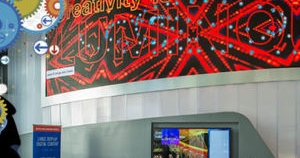In an ideal world, audiovisual customers and partners would receive complete creative freedom when it comes to the design of their display solutions. Instead, they are often boxed into thinking of digital displays only within the framework of the traditional rectangular shape. Everyone’s television at home is the same shape so their large-format displays outside the home might as well be the same shape too right? Wrong. Cookie-cutter commercial displays of uniform size and shape are cheaper and easier to produce than project-specific display products but for Dan Rossborough, the Nanolumens Director of Strategic Projects, these limitations on creativity are unacceptable. In his mind, digital display solutions are not rigid objects of predetermined shape that only fit in specific environments but rather are a free-form material that designers and architects can sculpt as they choose. As he wrote earlier this year, “the designers of today deserve digital displays that complement their vision and artistry, no matter if the shape required is a cylinder, sphere, free-form wave, or yes, even a rectangle.”
One of the missions of Nanolumens within the AV space is to make digital display technology more accessible to a wider range of consumers and audiences. This is why we offer a diverse range of self-education content on our website, it’s why we pioneered our Visualization as a Service program, and it’s why we refuse to shackle our potential partners to any single display shape when the best display for their space might be a complete departure from the standard 16:9 aspect ratio. In furthering this mission of ours, next week Dan will be leading a webinar that explores why exactly it is so important to have diverse design freedoms when specifying a display solution. In this webinar, entitled “Unbox Your Mind: The Designers Guide to Degrees of Freedom with Display Solutions,” audiences will learn how to spot the degrees of freedom differences between bespoke direct view LED systems and more commoditized competition as well as which precise specification freedoms set apart the high-end display providers from subpar substitutes. They will learn how the best LED applications natively complement existing architecture rather than compromising it and they will come to grasp why exactly LED should be seen as a freeform creative material rather than a predetermined product. Taking place next Thursday at 1 PM, what this webinar ultimately promises is that participants will depart with the knowledge they need to design the direct view LED vision that’s always lived in their head. There’s a new way to think about LED; let Dan show you what that means.

